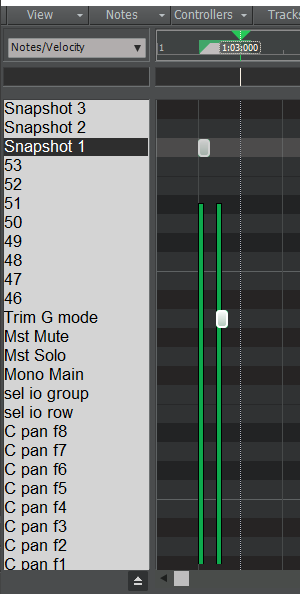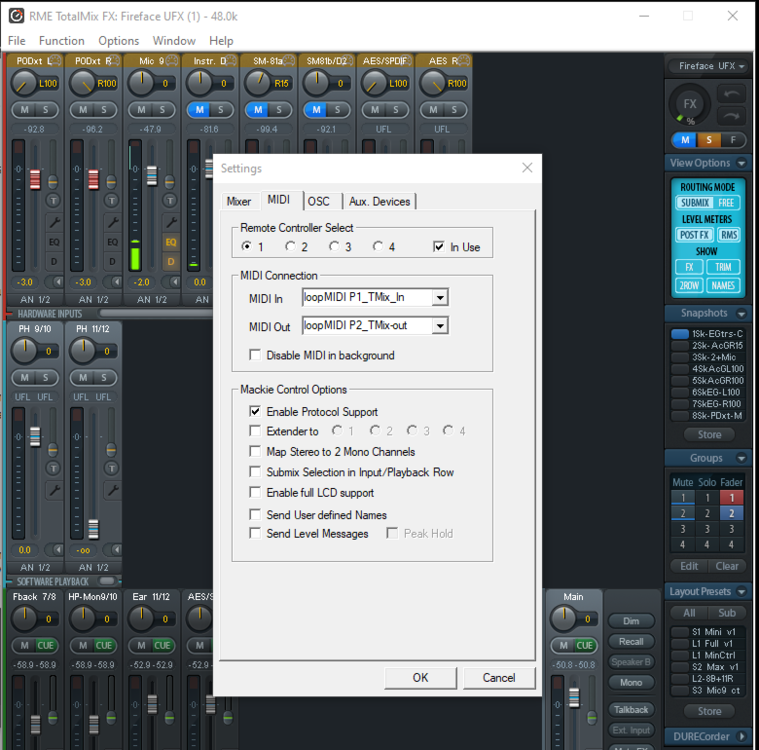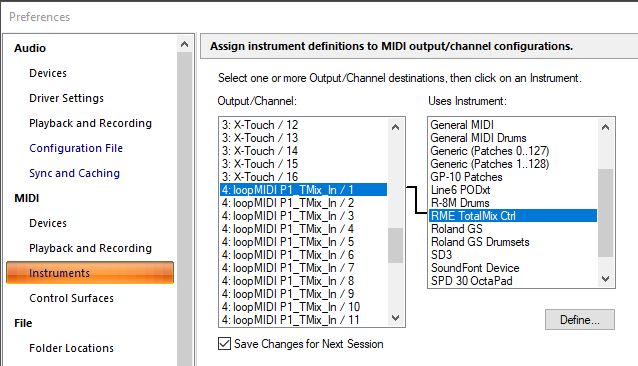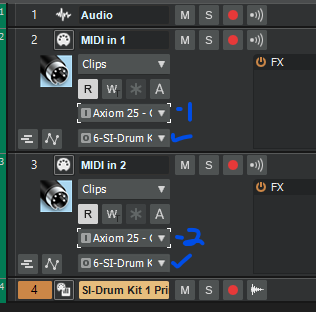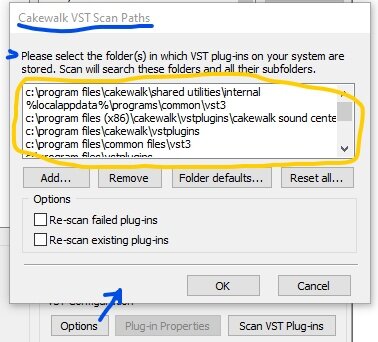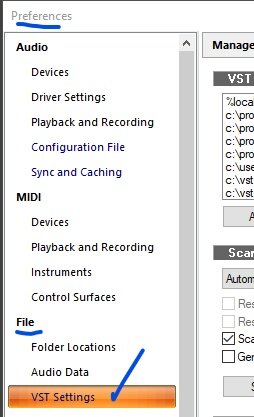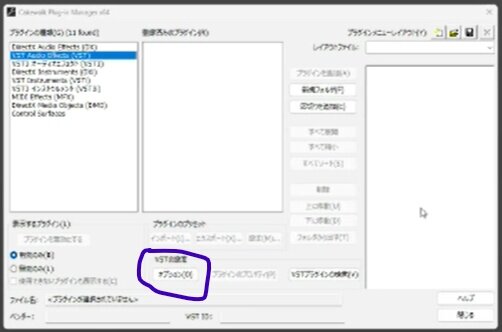-
Posts
330 -
Joined
-
Last visited
Everything posted by JnTuneTech
-
Wow - I didn't even think of trying to use hi-hat pedal control on SI drums - and do they really even have actual pedal control I wonder? Usually only the full-featured drum samplers have that. -I really do hope you find a way to get a good drum VSTi to try this stuff out, or you may be disappointed with the results! Such a nice set of pads deserves a good virtual kit. Even cheaper virtual drums can get by with decent one-shot samples & minimal layers on a lot of the kit, -but the one thing that really sticks out to me is when the hi-hat can't truly be expressive - at least with rock, country, of course jazz styles for heaven sakes. But the good samplers do seem to be getting closer recently. -You should definitely try your 1st method, chaining the MIDI and then into the Scarlett input, I think. using basic short MIDI cables between two devices and a decent PC interface never caused any latency issues for me. -I still have an OctaPad that I often chain through another Roland legacy keyboard, and then into my PC interface, and have had no latency issues. -Of course, your mileage may vary. But it can't hurt to try - you have all the gear already. Recording two tracks for separating kits can be good, but it still is best as John said to make sure each kit piece has a separate MIDI note, so that there are no duplicate notes assigned between the two kits. -Almost essential really. And chaining both controllers with same MIDI channel would not change latency, but if there are duplicate notes between the kits - again, there would be big problems with that, -I'm sure that's why that method was recommended. Plus, control info, such as hi-hat pedal position, would overlap. -Anyway, keep at it, you will find a good setup!
-
Cakewalk .ins - Instrument Definition file for RME TotalMix app (MCP subset plus RME) MIDI control mapping. ______________ -This definition file can be used as a way to graphically change the Cakewalk keyboard note representations in PRV, to help in quicker MIDI note placement, and subsequent viewing & editing, when triggering RME TotalMix track button states via MIDI. -It may also be minimally useful in connection with any MCP (Mackie Control Protocol) capable device, as by design RME incorporated basic MCP mapping into their MIDI control implementation. As of this writing, RME has recently released the latest iteration of their flagship audio interface - the Fireface UFX III. In recognition of that, -and seeing as how I created this Cakewalk ins file specifically to use with the original UFX when connected to Cakewalk, which I do still use almost exclusively as my audio interface, I am posting a copy of this file here should anyone find it useful! CbB_RME TotalMix Ctrl.ins Notes and Caveats: 1) This is a very basic instrument definition implementation, meant primarily for quick MIDI control mapping of basic RME TotalMix app button functions, and some MCP programming, which RME implemented in their app many years ago. It has not been updated for any changes since about 2010, and the primary source for the information on how the RME application is set up for this can be found in the RME TotalMix and device documentation. -It has been working for me flawlessly through all RME & Cakewalk software iterations since then. 2a) MIDI CC 7 - which is nominally output on start and use of a MIDI track in Cakewalk, will also natively control the Master Volume fader (MCP, and/or as assigned in RME TotalMix), when the Cakewalk MIDI track output is assigned to the RME TotalMix MIDI connection, and set to MIDI channel None or 1. It will continue to map to that control when the Cakewalk MIDI track fader is moved, and/or indicated with an envelope, and/or if embedded MIDI CC 7 messages are inserted into the track. 2b) -ALSO - Note that leaving the Cakewalk per-project setting - Preferences - Project - MIDI - Other Options: Zero Controllers When Play Stops - in the on (box checked) state, will cause TotalMix fader positions to go askew when the transport is stopped (when the TotalMix app MIDI output connection is active), whether or not the tracking is muted, etc. 3) I have included MIDI CC basic mapping for VPOT (rotary control) in track-pan mode (MCP and RME), -but for experimentation only-. As the VPOT pan control implementation in the MCP protocol is very low-level programming intensive, the use here has only worked for me in a few cases, creating small CC ramps in Cakewalk PRV, and editing the events one-by-one afterwards. -To get a programming explanation of how this function works in MIDI CC programming, you might refer to this Bome forum post: https://forum.bome.com/t/motormix-pan-knobs-using-mackie-mcu-protocol/1076/3 -Otherwise, it is actually Much Less Frustrating to just connect a MCP-compatible control surface, and record that kind of programming from that source - FYI. 4) Adding this ins file, and using it to map a MIDI port assignment in Cakewalk is in the Cakewalk documentation. Usage of the MIDI control in the RME TotalMix app - with an RME device, is in the RME documentation. It is best to gain a full understanding of all of those factors, before using this file, as I cannot cover all the possible options & troubleshooting. -Use the docs - they will be your official support. Normally, the basic use for this, in my workflow in Cakewalk, has been like so: I create a MIDI track in almost every project that I will play and perform with, to choose, and/or dynamically change the RME Snapshot selection, as well as the master volume level, and often the track mute states for the mixer in TotalMix, as the project plays back. -This is very useful for me, as that determines what I hear via the headphones mixes, and the output (to a PA for instance), of the complex I/O of the RME audio interface, programmatically. -Having a quick way to reference the exact notes needed to accomplish this, via changing the Instrument Definition - note names in the PRV for that control track, helps me set up and view my programming simply. Generally, just adding a note value at the default of 100 velocity, will suffice, and as mentioned, adjusting the MIDI track volume will also control the designated master out level, so it's fairly simple. -Again, for anything more complex, using an MCP-compatible control surface, routed in to the Cakewalk MIDI track, and recorded, will provide much of the rest of the possible controls (such as track fader volumes, etc.). Finally, to use Cakewalk to control RME TotalMix, both installed on the same PC, I use loopMIDI to create a set of virtual MIDI ports to connect the two apps (both are used when using a feedback-capable MIDI controller). -There are also ways to implement remote MIDI control via networking, or OSC, if you want to experiment with having Cakewalk MIDI control the RME TotalMix app on a remotely connected PC with an RME audio interface, such as from an offstage control booth to an onstage sound system. -Many possibilities, and they are still developing all the time. In any case, I hope someone finds this as useful, as I have. -Though I do still wish there was easier way to create/edit .ins files available, feel free of course to re-use or modify this one as you see fit. -Jn-
-
- 1
-

-
That can be accomplished several ways in Cakewalk. I like to use plain MIDI tracks - as opposed to Instrument tracks, for inputs in Cakewalk. Then I also load VSTi synths individually (again, no instrument - combo track). If you use that method, for instance, you can create (at minimum) 2 separate MIDI tracks - 1 each for the TD-6 input, and the TD-8 input, and label them MIDI in TD-8, and MIDI in TD-6. -I don't know exact TD-series assignment details, but by your description, I would then: Set the MIDI in TD-6 track input (In / Out section in the track inspector, etc.) using "(Focusrite MIDI in) [TD-8] - MIDI Ch. 11" (again going by your drum module & chaining settings description above) - and the MIDI in TD-8 track input using "(Focusrite MIDI in) [TD-8] - MIDI Ch. 10" (those assignments names I am guessing, but you get the idea I hope!). -In that way, you can then route either, or both of those inputs, to the synth of your choice, in the output selection of each track's properties. -I don't know if SI Drums responds to multiple MIDI channels, but if you play around with the MIDI channel assignment (in the track inspector - MIDI Channel properties) you can make the output channel the same on each of the two MIDI (input) tracks, -or whatever works. Below is a simplified general example screenshot - from the track view perspective (depending on zoom, etc., you may need to adjust..) In it there are two MIDI input tracks, each uses the same MIDI device, but the input channel filter is different for each one. Then, they both output to the same synth: -In the example, I don't have Input Echo = On - so you would also need that engaged (button lights up) to play through and drive the synth - don't forget that. -You could also record both MIDI tracks, and later modify each one separately if needed, etc. -Or not. And, a similar routing could be used if you want to play MIDI tracking out to the drum modules, -provided the MIDI pass-through works that way on them, I suppose. MIDI thru has changed over the years. -You don't mention your Cakewalk MIDI output settings, maybe you don't use the modules that way. As @John Vere mentions, SI Drums is very minimal, but you could always have several instances, each with different kit pieces. -But I agree with him - on that angle you would be better off with a better drum VSTi, but that would not likely be free, of course. And then too - using the audio output(s) from the drum modules, or a combination, is possible for layering things too - unless you don't want those sounds. -But anyway - routing is the key, though it can confuse the best of us. Sounds like you are working on it - just keep at it! -I can only hope this helps.
-
You know, I did have an issue getting duplicate screen capture copy images out of my post at around that time too. In fact, I purposely had to close the browser, and entirely re-do my post. Again though, I don't know how the image uploads got crossed over to you - really odd!
-
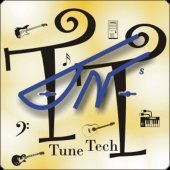
BBCSO Template - Reduce volume MIDI or Audio track?
JnTuneTech replied to sadicus's topic in Cakewalk by BandLab
Way too many variables inherent there, including the qualification - "better" - to answer that generally! I say - Use which ever method works best for you, in the particular tracking you are doing at the time. The name on a synth there is a default assigned by the plugin on loading - you can rename it after loading in synth rack view. Hmm... I don't think turning off a synth, well, I don't think that means what you think it means... Generally, the synth rack view can be used to insert or delete synths, and let you have another way to view their properties. There is much more in the documentation. Not sure what I can say about the rest, maybe someone else can cover that. -But you do seem to be figuring it out even as we try to keep up with stream of consciousness-ness! ? Just keep going - you're doing fine! -
@HIBI I can see where those images came from. -I can only think that we posted at the same time, and the forum somehow combined uploaded images? I certainly did not expect that. -Knowing any solution for that is completely beyond my pay grade! -Carry on I guess. ?
-
Thank you for your effort in posting here, translation can be very difficult. I may not completely understand your questions. So: Your video shows no VST location being set in Cakewalk. -Unless there are other computer issues causing that, you should try this: Select "Options" to see what settings you have. Yellow circled area - should Not be Blank. (Pictured settings are example only) -If Not blank: -You perhaps have moved files from those folders? So: Check those locations as listed on your computer with your file manager. These settings can also be checked and set fully in Preferences - File - VST Settings. So: Make sure you have the proper settings for your needs. Be careful. Do not move all files from those folders when attempting to fix one VST problem. I hope these instructions help you to find what is wrong. Cakewalk will not work properly if important files are moved or deleted! My apologies if this guidance is not correct for your problem, or does not translate correctly.
-

General MIDI Assignment of Instrument to TTS-1?
JnTuneTech replied to dalemccl's topic in Cakewalk by BandLab
Well... in my experiences anyway - Melodyne is usually only partially right, even with the newest versions and CbB. -At least it is fast, so I can do it quickly, then open the Cakewalk tempo track view, to see where it got lost. And don't get me started about how it decides the BPM, especially on any track with multiple time changes. -And if your subject material has very little or no rhythmic transients... I could go on, but suffice to say it is different with every track I have done so far. The suggestions about running track separation algorithms is interesting, -thank you for that. I would have to see if the time and resources it takes to do that as you excellently point out, would truly be worth it. As of this writing, I have yet to see any audio extraction capable of pulling a full & accurate piano chart out of the middle of a mixed commercial track, nor converting the orchestral pieces in the backing track of the same into a useable MIDI arrangement. -Maybe someone like Giles Martin can almost do it in an expensive professional studio (read up on the latest reconstructions that have been made of Beatles archives, for instance) , but well, for me, not quite. -Now, of course, as time goes on, and tools such as AI and ever-increasing processing power become available for folks like me, that may change, -to be sure. For now though, most of the time I do actually get useable tempo extraction from Melodyne, and/or one of several methods available in Cakewalk, and combining that with an accurate MIDI transcription, and plain old manual entry (wow - actually playing an instrument - no way!), it's quite easy to cover an existing tune reasonably well, and as mentioned, also have the original on the tracking to refer to when needed. Of course, the more complex the material, the more work it takes, but that is part and parcel, as they say. -But hey, all good suggestions here, no question about that! And using TTS-1 to get a rough draft of a MIDI arrangement can be very useful to some of us, but if it's not your thing, -carry on! -
No, and Yes. Fast Bounce will work for a lot of FX & VSTs, but of course there are also many that don't properly handle it (most of that is not up to Cakewalk). I suggest learning which plugins give you problems, and then either bouncing tracks with those plugins in them separately, or trying a different plugin entirely, if you must have instant full-mix bounces working all the time. -As with everything, there are times when you will have to wait longer for the good things, I guess, if that helps any! I do also feel that saying "if a plugin or a VST is not fully loaded, fast bounce should wait until all this is resolved; a reverb should be completely calculated, right?" - in itself perhaps belies the idea of a "fast bounce". - Might that procedure take as long (or longer) for the DAW to complete than live playback? -I am not a programmer, so I don't know for sure, however again, I know some plugins facilitate all that, and some not so much. I do agree that it can be frustrating to find out after all the work, especially waiting & then listening for errors on top of everything else. I get that.
-

General MIDI Assignment of Instrument to TTS-1?
JnTuneTech replied to dalemccl's topic in Cakewalk by BandLab
Too true, and often they are useless to even salvage anything from! -But every so often, some are very meticulously arranged, and I am amazed to find them offered up for free - much like Cakewalk here! -My best batch (I am still sorting through them now & then) comes from downloads I found in the later 90's - early 2000's (ouch!) - and I have stopped searching for them now because of the ridiculous amount of scams & misdirection, data collection, and of course malware linked to searching anything "free". Well done ones can be so helpful. There are also vendors who sell MIDI arrangements, I have used a few from MIDI-Hits, and they used to supply .wrk file formats for Cakewalk, but I had several terrible renditions they sold that put me off. Anyway - Unless you are trying to cover something like Rush or ELP, a basic drum, bass & piano arrangement with at least proper timing, structure, and key can help save time, and even teach a bit. -The better ones can make up for not having an expert keyboard player (I am not), and save time setting up drum tracks, etc. At one time (again, ouch), I started using Cakewalk (Sonar) to transcribe parts in printed songbooks to MIDI, using the staff view. I still use those tracks now & again, but I doubt I could go that way now, too tedious! But sometimes it also helps to have a MIDI transcription to learn & play along with - by using the staff view as it plays along with the tracking (yes, I know staff view is not all that, but then again, neither is my ability to read printed music). I bet it could be helpful with teaching, -that is, if they continue to teach music in schools anyway.. But again, -I digress! -
I have been thinking about the "varispeed" simulation suggestions, & current workarounds for a while now, and still wondering... 1st of all, true varispeed involves changing both the speed and pitch. @Rick Lang seems to be seeking speed change, not necessarily pitch. If so, the reference pointed out above by @reginaldStjohn would be OK, but in a studio environment, probably doing that via a temporary mixed track - audio in one track, MIDI as is, would be more reasonable & likely to suffer less performance-wise, I would think. Then just export the MIDI created in the slower version, import that back to the full version, etc. As for truly changing both the speed and pitch, -as happens with changing tape transport & capstan speeds, I have used the method described by Craig Anderton. How to Do True Tape-Type Varispeed in Cakewalk/Sonar It works, and again, I find it most useful on a single audio track at a time. The limitation there is that you have to MIDI tempo match to the new file created, play in your new material, and then integrate that back into the original speed project, which takes a lot of work. Probably fine for drum MIDI work, but overkill if you don't need the pitch change as well. I haven't tried any of the other DAW solutions for varispeed emulation yet - do they all work so simply, or are there limitations, such as increased latency, audio degradation, etc? Any other experiences out there?
-

General MIDI Assignment of Instrument to TTS-1?
JnTuneTech replied to dalemccl's topic in Cakewalk by BandLab
FWIW - It should also be helpful to know that tracking MIDI using a DAW like Cakewalk can be somewhat confusing if you forget the internal possibilities of MIDI files themselves. Older GM MIDI files can contain information that won't initially be obvious to a casual load & playback with a GM synth (virtual or otherwise). -Depending on your workflow & preferences, you may want to switch to using Cakewalk-style MIDI tracking completely, rather than using the MIDI embedded control information, -or vice-versa, -again it depends on your preferences. Typically, in my workflow for instance: I will take a "look" at a GM MIDI file I have downloaded (scary thing to do nowadays though, -but I digress) by opening the file directly from the project file-open function of Cakewalk. -If it opens properly, a type 1 GM formatted file will present 1 or more tracks, each having a separate channel and possible output routing (p.s. there can be more than 16, and in those cases, a separate instance of a GM synth, such as TTS-1 is advised for each group of 16 tracks - or duplicate channels, etc.). If it looks like something I may be interested in, I will do a "save as" and thus convert the opened file into a Cakewalk project. After that, I usually add TTS-1 as an instrument (I prefer to load it separately, and then retroactively assign the MIDI tracks, but that is by choice) in Cakewalk. -Tip 1 - TTS-1 track volume can be louder than comfortable with many MIDI files, so I start with pulling the fader on the TTS-1 down a bit-FYI. -Then, I click-select any of the MIDI tracks I want to preview, one by one while holding down the ctrl key (on PC), and while still holding down the ctrl key, select the output of that final selected track to point to the TTS-1. -At that point, you can usually start playing the file, and you can preview the initial results. From there - I usually use Event Viewer to see what MIDI control events are present, -if any, other than note and pedal events are embedded (that will all vary depending on your tastes & needs), I usually delete the non-performance elements - again, per preference. Often, I will also "sanitize" the MIDI further by exporting the "cleaned up" version I have created as a new type 1 MIDI file, which can then be imported into a Cakewalk project/template, although without tempo or time changes, etc. My goal usually is to make the downloaded MIDI tracks set up as performance-customizable as possible - so that I can then use more graphical controls in Cakewalk tracking, such as envelopes, and to clean up anything that might get in the way of creating clips & copying parts, etc. -There are mix-and-match methods too, but I find simplest is best in the long run. Usually, if I find a MIDI track that seems to have odd playback issues on a VST synth, for instance, it is often related to embedded MIDI commands that you can't always "see" right away in track or PRV. -FWIW. -

General MIDI Assignment of Instrument to TTS-1?
JnTuneTech replied to dalemccl's topic in Cakewalk by BandLab
I guess I should have said it better - sorry! -In type 1 GM MIDI files, the tracks themselves are defining the initial data for the bank/patch, volume, pan, and so forth. -Any of the things you see in the Cakewalk MIDI track control section itself. -So, they are not actually events that will be shown by event view, though perhaps there is a utility somewhere that can show that data, I am not sure, as I just use the track controls to tell me what those values are when I first load the MIDI file. There are other ways to add/change the initial settings (events) that the track(s) themselves define on loading, but that didn't seem to be what you are asking? As I say, initially, the track settings from the GM MIDI file are what tells TTS-1 how to start, and again, those aren't shown in the event view. -Ongoing events in the track (as can be seen in event viewer, for instance) are those that happen after the initial per-track GM information. -In addition, there can be attached sysex data events, which generally apply to initializing a specific MIDI device, and so on, and I rarely let those pass through to TTS-1 (I delete them). So basically, it's hierarchical - track data sets the initial instrument (bank/patch),along with volume, pan & so forth, and then any changes thereafter are implied in values - along with notes of course, that come along in the time information of the tracking. Cakewalk MIDI track controls generally cover all the GM settings that apply to initial track data information that can be recalled, as well as of course modified and saved/exported again. -If I recall properly,, type 1 GM MIDI specifies a separate track for each "instrument" - which I think is also determined/linked to the track channel, starting from 1 thru 16 - as opposed to GM type 0, which just puts all information into one "track". Some other standards are generally used, as channel 10 data is typically drums or percussion, etc. -Search the Web for GM MIDI Type 1 specifications, and it should be much more thorough - but I hope this helps! -

General MIDI Assignment of Instrument to TTS-1?
JnTuneTech replied to dalemccl's topic in Cakewalk by BandLab
The type 1 GM MIDI files can contain bank/patch info on each track, which is what points TTS-1 to the planned instrument, just like the channel & volume, etc. is set initially as well. The event list info is also still helpful, because many MIDI files also contain individual programming messages that will then override the initial track settings. -
We are more likely to see plugin functionality handling of multi-channel spatial audio from Cakewalk tracking, than to have it integrated. And as @Lord Tim mentions, the licensing for all the constantly changing formats out there makes that pretty much a necessity. -I have seen this with the media encoding world in general. You can usually find several 3rd party encoders for various & sundry formatting, and they will be designed to either integrate with your mixing software (as in a plugin), or they will specify a multichannel master file be created for import & processing offline. -I'd be happier with Cakewalk sticking to the basics on that front myself anyway.
-

Event List change multiple notes to same pitch?
JnTuneTech replied to sadicus's topic in Cakewalk by BandLab
It really is great to learn from these discussions, invaluable really when good positive folks bring the knowledge! So - as to the original OP - never mind about Event List stuff I initially suggestedfor this. I now would just use what @Bristol_Jonesey does in the post above. And, since you only asked to change selected MIDI note pitch, and seem to indicate having issues with not seeing the results, just do it on what you see/have selected in your PRV at the moment. -I also found that if the first note in your selection is already at the pitch you want all the others to become, it will be quicker, as that value is what the Event Inspector will start with for you to pick. I had never looked at that tool much, so this is great learning for me. -But I do still use the Find/Change tool for mass MIDI note & data editing very useful, -it's just in the case of the OP situation/post title here, it can be a bit overkill! -

Event List change multiple notes to same pitch?
JnTuneTech replied to sadicus's topic in Cakewalk by BandLab
@sadicus - I don't know about any video, but maybe there is documentation, though since I suggested this, I will test... So: I cannot reproduce what you had happen. Perhaps you are doing the steps differently, I cannot tell from the screenshot. I did what you described, on a MIDI track of my own, selected a bunch of notes, find / change only one pitch, and move that pitch, and it works every time for me. My steps, for moving notes as you described, in case it helps: 1) Select a group of notes you want to act upon. -Carefully. If you have other things selected offscreen or whatever, there are consequences! 2) Click on the CbB file view menu - Process - and select Find/Change. -The Event Filter - Search window should come up. -This is 1 of 2 phases, and don't close the windows in the middle of the process to re-select things, or you will need to start over, and maybe undo if it went wrong. 3) Click on "None" on the bottom right of that window. Then, check the box next to "Note" in the upper left. (If you repeat this operation during a session, the last used settings will already be there). [P.S. What you show in the screen shots for this looks right] 4) Make a selection choice. -As in your example, start and end note value being the same will select just events of that note value, etc.. -Click "OK" to get the 2ond window. 5) Event Filter - Replace window should be there now, blink and you will miss the change, looks exactly like the other, except for the title. - Make a result choice. As in your example, selecting start & end note being the same (but different than the 1st selection) will result in moving the selection to the Replace choice. -Click OK, and the matching selected notes should have moved, -unless they were not included in the choices you made. -Works fine for me, but perhaps some step was skipped - or something I can't see happened on your end. Nothing moves in my tests until both windows are done, not sure if that screen shot makes sense there... Anyway, that's one use of that tool. Most of the time I use it to modify velocity range, on a track full of notes that were input without much regard for velocity, or ones that just need refinement to match the sampler velocities I want to hit... -Anyway, keep at it, or maybe you've already figured this one out by now! -

2 MIDI Keyboards Simultaneously Active?
JnTuneTech replied to musikman1's topic in Cakewalk by BandLab
@John Vere - The video is plenty helpful as is, don't let the little things stop you! -Ah yes, older... Dee Long wrote a song with that title in the 70's, and I know more now each day what he was leaning into... Actually, he is still at it too, so there's examples for all of us. I just try to get some good sleep, get up another day and try again! I don't know about you folks, but I seem to have had much less issue with keyboard - VST latency issues since about the time CbB came out. -Of course, maybe my recent computers have had better USB subsystem connectivity, as I know some of my old PCs had lousy USB performance across the board, but since CbB, Windows 10 1909 or so, my latency issues with MIDI and well-behaving VST instruments has become almost a non-issue for performing even live. Multiple keyboards too. -Maybe I have been lucky, as I see a few more threads here about latency issues, we will have to see what they are getting into I guess! -

Event List change multiple notes to same pitch?
JnTuneTech replied to sadicus's topic in Cakewalk by BandLab
The first couple of times I tried that tool, it almost put me off - very numerical & almost unintuitive. But, over time, I have found it great for taming wild batches of MIDI notes! ? -

2 MIDI Keyboards Simultaneously Active?
JnTuneTech replied to musikman1's topic in Cakewalk by BandLab
I listened again, and it seems to be on the narration, and again, only near the end of the video. -I only noticed the most with the small speakers on my work laptop. But it's there in headphones too. -I almost feel bad, -not trying to rail on you - just want to help!! These things happen to the best of us. ? -Oh, and if you do update it eventually, you might mention that cheaper keyboards also can have mechanical delay, as some of the cheap keybeds (some of the Akai controllers, for instance) have very cheap contacts, flimsy keys. So that can throw off the measurement process as well. -Not huge, but it all adds up. -Ah, the modern world. -

Event List change multiple notes to same pitch?
JnTuneTech replied to sadicus's topic in Cakewalk by BandLab
1) Multi-select and changing values in Event List - 2 separate things. Also, the view dialog, as in your screen shot, is for turning on or off (filtering) the events shown. 2) Going by your description & screenshot - I would be more likely to use the "Process - Find/Change" tool, on the MIDI track in question, on all notes at the same time selection (or whatever section, selected notes, etc., of the track you want). -Changing the values in Event View is an event-by-event process, at least it has been for me. -

2 MIDI Keyboards Simultaneously Active?
JnTuneTech replied to musikman1's topic in Cakewalk by BandLab
Definitely a good point to be clear on. There certainly were some old MIDI only devices I have had that used either bad drivers, or slow processing, but that was a long time ago. Most modern devices have little problem with it. -Even the USB class compliant - MIDI generics do just fine nowadays, in my experiences anyway. As per your video, most of the time folks are just getting audio latency, to be sure. -Even running my old MIDI 5-pin cabled legacy equipment through the modern basic USB class-compliant converters makes little difference, -compared to audio latency. @John Vere - Good work, maybe a bit more than most folks would probably want to try though - nowadays! -P.S. - I was getting a very constant scratchy sound in the audio mix on later portions of the video, when I played it from YT, using my laptop speakers, -dunno what it would be like with headphones... - did something unintended get introduced with the AV conversion maybe? -

TTS-1: One instance for many tracks vs. multiple TTS-1 tracks?
JnTuneTech replied to Dave G's topic in Cakewalk by BandLab
For me anyway - setting up, and certainly previewing a complex MIDI file or arrangement (or even mildly complex, 4 or 5 parts including drums), without something like the TTS-1 to get it started quickly, would, as @John Vere alluded to, be something I would not enjoy nearly as much. But if you don't use that type of workflow, then by all means, carry on! -I mean, I was really thrilled to get TTS-1 as part of Cakewalk, I had been looking for that in a DAW before I even got hold of individual virtual instruments, - way - back when of course, but it still holds true for me now. A multi-timbral synth with GM (which I know is in itself outdated) capabilities is, or can be, a very helpful Swiss Army Knife. As to the OP - I also suggest using it any way suits your needs, per project. No need to have a set pattern. And that's what works great with a multi-timbral instrument, use one track, or all available, export out anything you might truly keep to a file (mute the other MIDI parts, export..) - so many quick uses possible. I still find quick parts in the TTS-1 that are very useable, without having to pull up multiple libraries. -It took years (& tons of code) for Kontakt to even have some searchability, but with GM patches & a multi-timbral synth, I have been able to find all kinds of parts almost instantly, from one MIDI track in Cakewalk. -Try using the Patch Browser - search function, on a MIDI track routed to TTS-1, -or any properly indexed GM VST2 synth, and you will find a lot of sounds quickly. I will be sad to see that go, especially since VST3 seems to have done away with patch browsing from a track. I'm trying not to be a Roland fanboy, but I have always liked the GM compatible instruments they started early on with. And if all else, I will probably continue to use at least the Sound Canvas plugin from them if TTS-1 goes away, as those types of tools seem to have a lot of flexible consistency in them. -For me, anyway. -

2 MIDI Keyboards Simultaneously Active?
JnTuneTech replied to musikman1's topic in Cakewalk by BandLab
I have noticed, that for me anyway, if a USB MIDI device has 2 driver options, one that is generic USB (seems like there is a term but it escapes me right now), and one that is vendor-specific, or especially one that will only work with a vendor-specific USB driver installed, there are driver compatibility problems as they age out of support. -If you have that choice, and you only need MIDI connectivity, the built-in generic MIDI I/O drivers have worked fine for me, with no noticeable latency issues. -The above only applies to fairly recent devices, say 2010 & on or so, I think. And again, you usually only get basic MIDI functionality from that type of setup, so, if the device has audio and/or other functions, then of course you have to use the vendor supplied driver to get that functionality. I say that, because you mention an M-Audio USB keyboard, and I have one as well, and have weathered the OS upgrade & out-of-support issues with that as well. -My current M-Audio Axiom 25, which was just pre-AVID, has long been discontinued, and I found that as long as I just plug in the USB and use the generic driver, it works just fine. -No use of the programming functions, but all the keys & controllers work, and even the transport & other controls are fine with Cakewalk, and no latency issues. I have a recent Roland product that allows using just the MIDI without the vendor driver, it's a fairly common thing now. In fact, those type of devices can also often be used with a tablet or cell phone, as a generic MIDI input device. I have always opted to use the built-in MIDI ports on my sound device, for any keyboard that really seems old (like USB 1.0 era), and just cable up instead of using the USB, as I know the latency & drivers on those old ones will likely just make things sketchy. -But again, most recent USB devices have posed no major problems for me with Cakewalk. Even my control surface with USB has extra cabled MIDI I/O options on the back, and the USB driver is generic, -works fine. -Most of the controllers you are shopping will likely have some legacy MIDI, so just use that to connect the older keyboards.


